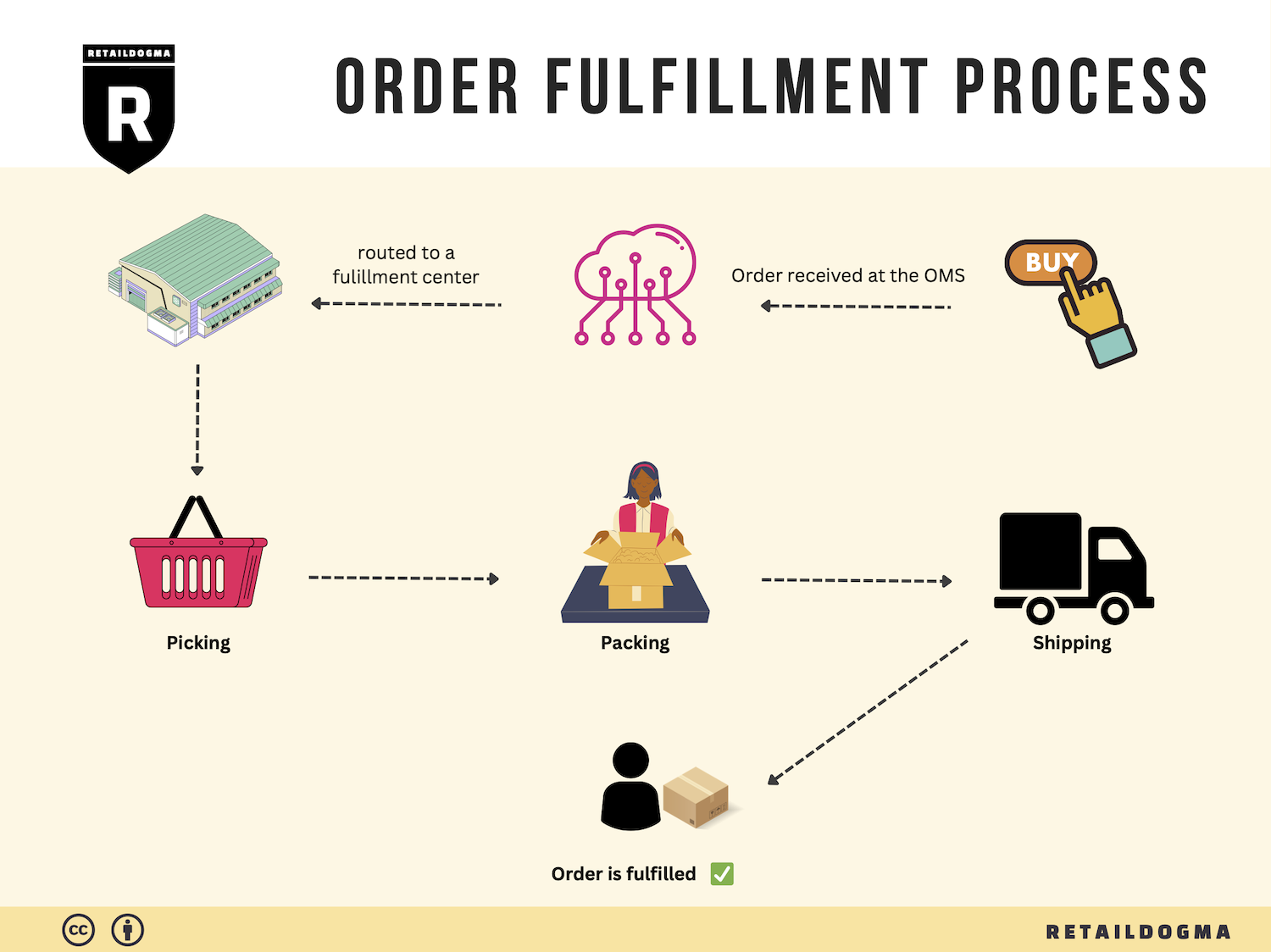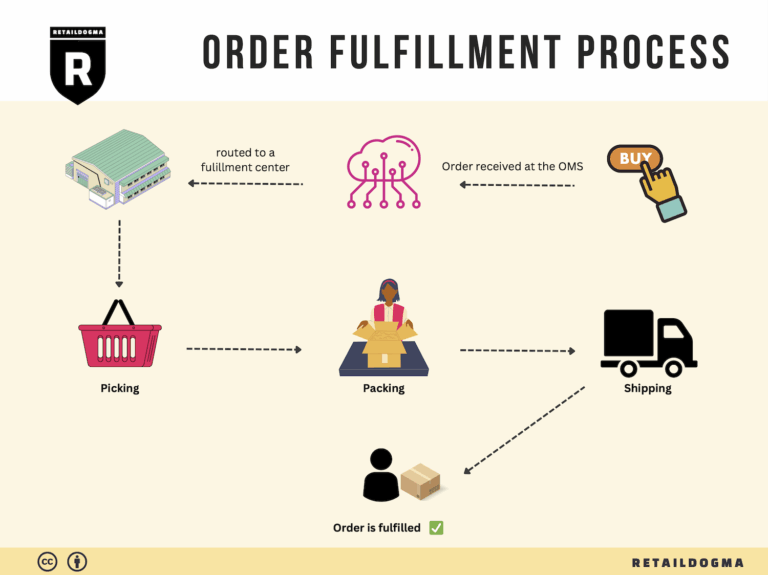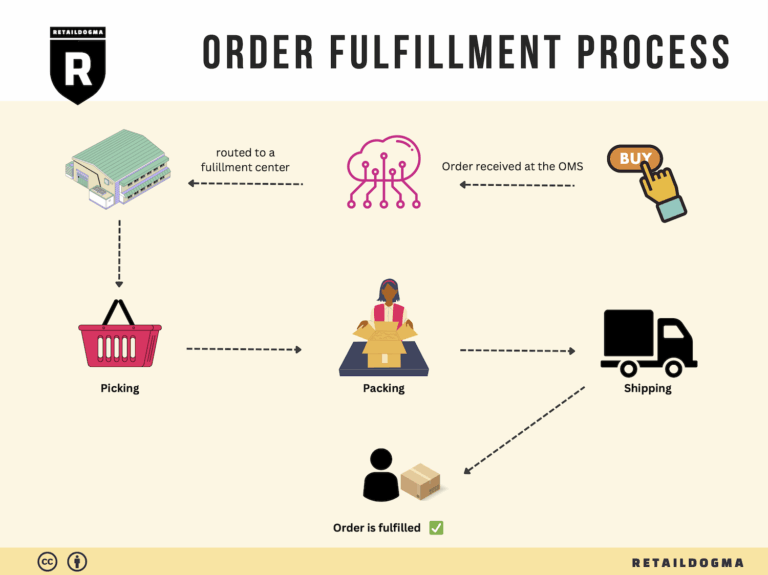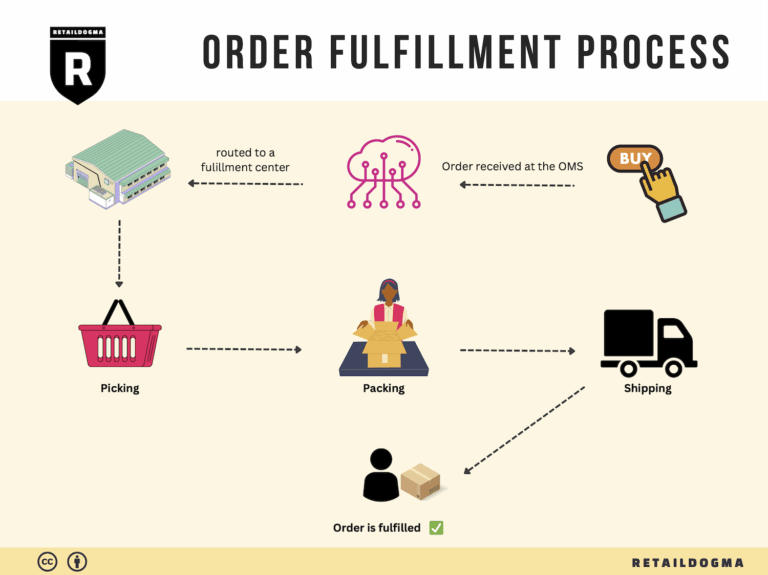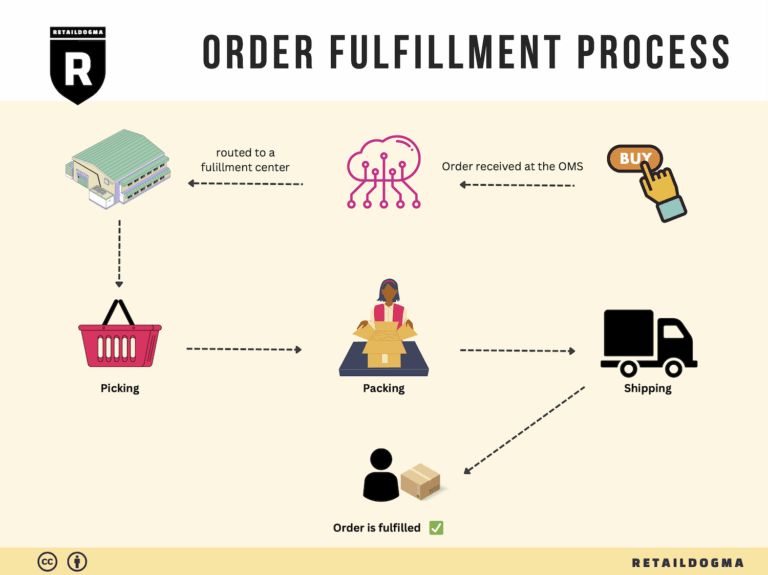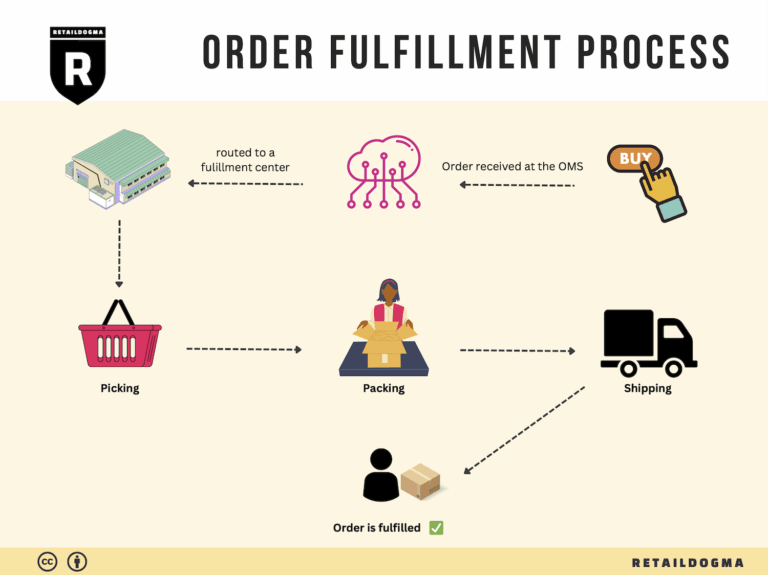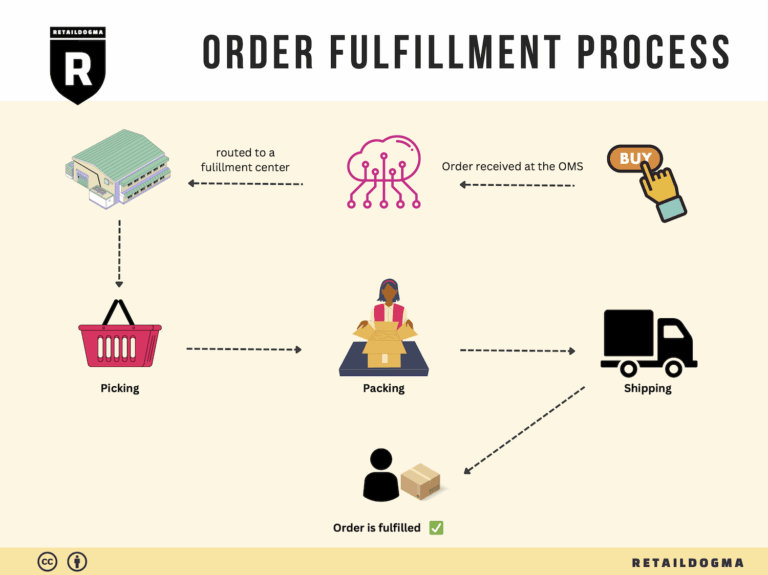Ecommerce Fulfillment Services: The Ultimate Guide (2025)
What is E-commerce Fulfillment? An Introduction for Growing Businesses
Understanding the Fulfillment Challenge
As your e-commerce business grows, the excitement of increased sales can quickly turn into the stress of managing inventory, packing orders, and ensuring timely shipping. Many entrepreneurs find themselves overwhelmed by the logistics of fulfilling customer orders, often leading to frustration and potential losses in customer satisfaction. This is where e-commerce fulfillment comes into play.
Fulfillment is simply the process of getting a product from your warehouse to your customer’s doorstep. It encompasses everything from inventory management and order processing to packing and shipping. For growing businesses, mastering this process is crucial to maintaining customer loyalty and a strong brand reputation.
What This Guide Covers
In this comprehensive guide, we will explore the various fulfillment models available to e-commerce businesses, including Third-Party Logistics (3PL) and Fulfillment by Amazon (FBA). Each model has its own advantages and challenges, and understanding these can help you make informed decisions about which is best for your business.
We will delve into the core services provided by fulfillment partners, such as inventory management, order processing, and shipping logistics. Knowing what to expect can help you set clear expectations and benchmarks for performance.
Choosing the right fulfillment partner is another critical decision that can impact your operations significantly. We will provide practical insights on what to look for in a fulfillment provider, including their technology capabilities, service levels, and geographic coverage.
Finally, we will discuss pricing structures and how to evaluate the cost-effectiveness of different fulfillment options. Understanding the financial implications of your choices will empower you to make decisions that align with your business goals.
Empowering Your Logistics Decisions
The ultimate goal of this guide is to equip e-commerce business owners, operations managers, and entrepreneurs with the knowledge they need to navigate the complexities of fulfillment. By understanding the landscape of e-commerce logistics, you can make smart, strategic decisions that enhance your operational efficiency, improve customer satisfaction, and ultimately drive growth.
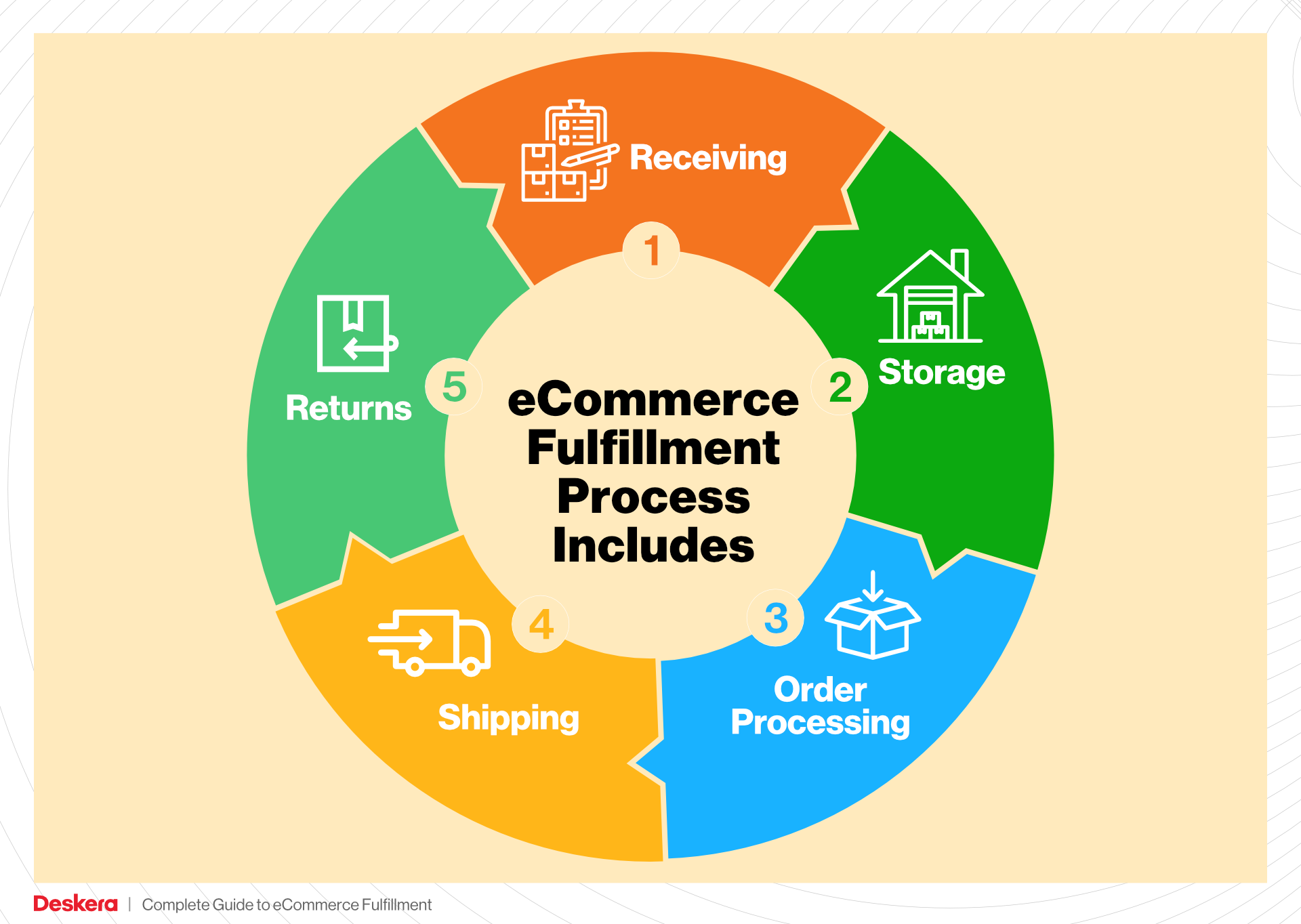
Whether you’re considering outsourcing fulfillment for the first time or looking to optimize your existing processes, this guide aims to provide you with the insights and tools necessary to succeed in the competitive world of e-commerce.
What You’ll Learn In This Guide
- What is E-commerce Fulfillment? An Introduction for Growing Businesses
- The Order Fulfillment Process: From ‘Buy’ Button to Customer’s Door
- Comparing Fulfillment Models: In-House vs. 3PL vs. Dropshipping
- A Deep Dive into Amazon FBA: Pros, Cons, and Who It’s For
- Core Services Offered by Fulfillment Centers
- How to Choose a Fulfillment Partner: A 6-Point Checklist
- Understanding Fulfillment Pricing: A Breakdown of Common Fees
- Frequently Asked Questions (FAQs) about Fulfillment
- Conclusion: Is Outsourcing Fulfillment the Right Move for Your Business?
- Important Disclaimer
The Order Fulfillment Process: From ‘Buy’ Button to Customer’s Door
1. Receiving Inventory
The order fulfillment process begins with receiving inventory at the fulfillment center. This step involves checking incoming shipments against purchase orders to ensure accuracy in quantity and quality. Each product is assigned a unique identifier, known as a SKU (Stock Keeping Unit), which helps in tracking inventory throughout the fulfillment process.
Importance: Proper receiving of inventory is crucial because discrepancies can lead to stockouts or overstock situations, both of which can negatively impact customer satisfaction and profitability. Additionally, an efficient receiving process lays the groundwork for effective inventory management, ensuring that products are readily available when orders come in.
Key Term: SKU – A unique identifier for each product that streamlines inventory management.
2. Warehouse Storage
Once inventory has been received and verified, it moves to the warehouse storage phase. Here, products are organized and stored in designated areas of the fulfillment center. Effective storage strategies, such as ABC categorization (which prioritizes inventory based on value and turnover rate), help optimize space and facilitate easier access.
Importance: Efficient warehouse storage is essential for quick retrieval of products when orders are received. Proper organization minimizes the time spent searching for items, which in turn reduces operational costs and enhances order fulfillment speed. A well-structured storage system also aids in maintaining accurate inventory counts.
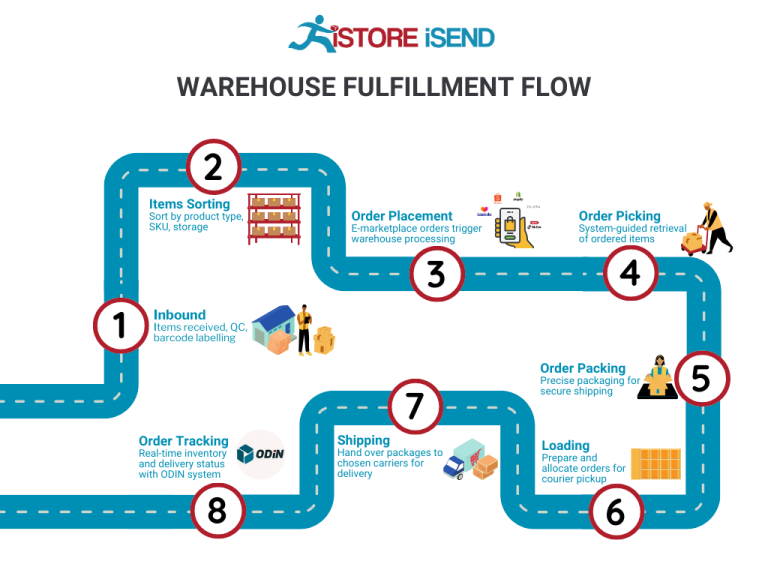
Key Term: ABC Categorization – A method of classifying inventory based on its importance and frequency of use.
3. Order Picking
When a customer places an order, the next step is order picking. This involves retrieving the items from their storage locations based on a pick list, which details the items ordered and their respective SKUs. Fulfillment centers often employ various picking methods, such as single-order picking, batch picking, or zone picking, depending on the volume of orders and the layout of the warehouse.
Importance: Order picking is a critical step as it directly affects order accuracy and speed. Efficient picking processes lead to faster order fulfillment, which can significantly enhance customer satisfaction and loyalty. Errors in this stage can lead to incorrect shipments, resulting in returns and increased operational costs.
Key Term: Pick List – A document or digital tool used to guide warehouse staff in selecting items for orders.
4. Order Packing
After picking, the next phase is order packing. In this step, products are carefully packaged for shipment. This includes selecting the appropriate packaging materials, ensuring items are secure, and labeling packages with shipping information and barcodes.
Importance: Proper packing is vital for protecting products during transit and ensuring they arrive in excellent condition. Additionally, efficient packing processes can reduce shipping costs by minimizing package size and weight. This step also includes verifying that the correct items are packed, further reducing the risk of shipping errors.
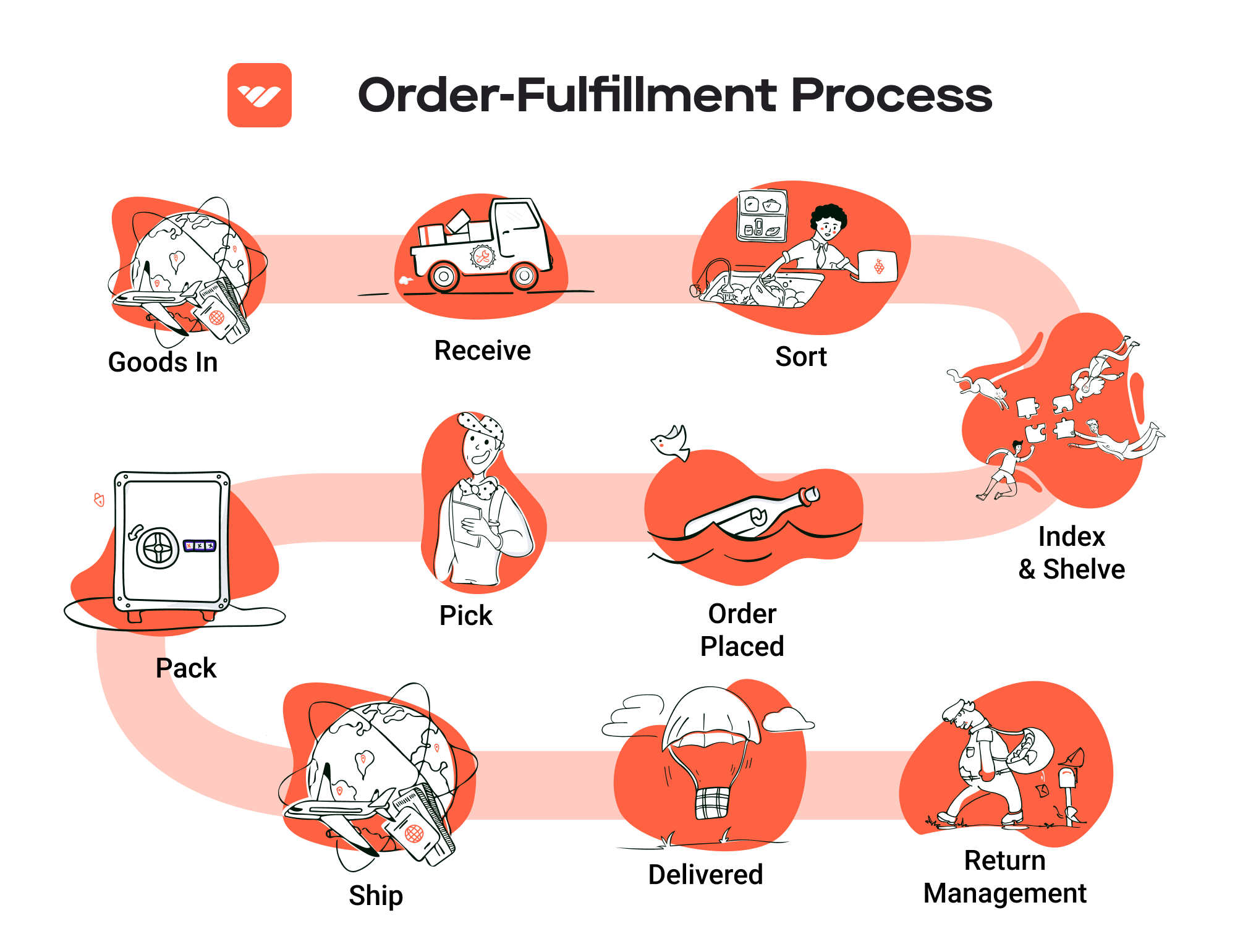
Key Term: Packaging Optimization – The process of selecting the right packaging materials and sizes to minimize costs and maximize protection.
5. Shipping & Delivery
The final step in the order fulfillment process is shipping and delivery. Once the order is packed, it is handed over to a carrier for transportation to the customer’s address. Fulfillment centers often utilize transportation management systems (TMS) to optimize shipping routes and manage carrier relationships, ensuring timely deliveries.
Importance: Shipping and delivery are the final touchpoints in the customer experience. Efficient shipping not only ensures that customers receive their orders on time but also influences their perception of the brand. With the rise of e-commerce, fast and reliable delivery has become a key competitive differentiator.
Key Term: Transportation Management System (TMS) – A software solution that helps businesses manage logistics, optimize shipping routes, and track shipments.
In summary, understanding each step of the order fulfillment process is essential for e-commerce businesses aiming to scale efficiently. By focusing on efficient receiving, storage, picking, packing, and shipping, companies can enhance their operational capabilities, reduce costs, and improve customer satisfaction.
Comparing Fulfillment Models: In-House vs. 3PL vs. Dropshipping
Fulfillment Model Comparison
| Model | Who Handles Inventory | Best For (Business Stage) | Key Advantage | Key Disadvantage |
|---|---|---|---|---|
| In-House Fulfillment | The business itself | Established businesses with stable order volume | Full control over inventory and processes | High overhead costs and resource requirements |
| Third-Party Logistics (3PL) | Third-party provider | Growing businesses needing scalability | Cost-effective, scalable solutions with expertise | Less control over logistics and fulfillment processes |
| Dropshipping | Supplier or manufacturer | Startups or businesses with low initial investment | Low overhead; no inventory risk | Lower profit margins and potential quality control issues |
In-House Fulfillment
In-house fulfillment involves managing the entire inventory and logistics process within your own facilities. This model is typically best suited for established businesses that have a stable order volume and sufficient resources to maintain warehouse operations. One of the most significant advantages of in-house fulfillment is the level of control it affords. Businesses can customize their fulfillment processes, ensuring that they meet specific quality standards and customer expectations. This control extends to inventory management, allowing for precise tracking and handling of products. However, the downsides are considerable. Operating your own warehouse requires substantial investment in facilities, staffing, and technology. Overhead costs can be high, and businesses may struggle to adapt quickly to fluctuations in demand, which can lead to inefficiencies and waste.
Third-Party Logistics (3PL)
Third-party logistics (3PL) providers, such as Cart.com, offer a robust alternative to in-house fulfillment. By outsourcing warehousing and distribution, businesses can focus on their core competencies, such as product development and marketing. This model is particularly beneficial for growing businesses that need to scale their operations quickly without the burden of managing logistics. 3PL providers offer cost-effective solutions, leveraging their expertise and established networks to streamline fulfillment processes. They often provide access to advanced technology for order and inventory management, allowing for real-time tracking and analytics. However, using a 3PL means relinquishing some control over logistics and fulfillment processes, which can lead to concerns about quality and service consistency. Businesses must also ensure that their 3PL partner aligns with their brand values and customer service standards to maintain a positive customer experience.
Dropshipping
Dropshipping is a fulfillment model where the retailer does not hold inventory but instead transfers customer orders directly to the supplier, who then ships the products directly to the customer. This model is ideal for startups or businesses with limited capital, as it significantly reduces the financial risk associated with holding inventory. The primary advantage of dropshipping is the low overhead; businesses can offer a wide range of products without the need for extensive warehousing or inventory management. However, dropshipping comes with its challenges. Profit margins tend to be lower compared to other fulfillment methods, as retailers must pay the supplier for each item sold. Additionally, there can be quality control issues since the retailer has little oversight over the manufacturing and shipping processes. This lack of control can lead to customer dissatisfaction if products do not meet expectations or if shipping times are longer than anticipated.
Conclusion
Each fulfillment model presents unique advantages and disadvantages that can significantly impact your e-commerce business’s operational efficiency and customer satisfaction. In-house fulfillment provides maximum control but at a high cost, while 3PL offers scalability and expertise at the expense of some control. On the other hand, dropshipping minimizes financial risk but may lead to lower profit margins and potential quality issues. As you consider which model aligns best with your business goals, it’s essential to evaluate your current stage, resources, and long-term growth strategies to make an informed decision that supports your scaling efforts effectively.
A Deep Dive into Amazon FBA: Pros, Cons, and Who It’s For
Understanding Fulfillment by Amazon (FBA)
Fulfillment by Amazon (FBA) is a service provided by Amazon that allows sellers to store their products in Amazon’s fulfillment centers. Amazon then takes care of storage, packaging, and shipping of the products, as well as handling customer service and returns. This service enables sellers to leverage Amazon’s vast logistics network and customer base, making it easier to sell products online.
How FBA Works
-
Set Up Your Account: Sellers first need to create an Amazon seller account and enroll in the FBA program.
-
Prepare Products: Sellers must prepare their products according to Amazon’s guidelines, which include labeling and packaging requirements.
-
Ship to Amazon: Once products are ready, sellers ship them to Amazon’s fulfillment centers. Amazon has numerous warehouses strategically located to optimize shipping times.
-
Storage: Products are stored in Amazon’s warehouses until they are sold.
-
Order Fulfillment: When a customer places an order, Amazon picks, packs, and ships the product directly to the customer.
-
Customer Service: Amazon handles all customer inquiries and returns, allowing sellers to focus on other aspects of their business.
-
Sales Reporting: Sellers can track their sales and inventory through Amazon’s Seller Central dashboard.
Pros of FBA
1. Prime Eligibility
One of the most significant advantages of FBA is that products fulfilled by Amazon are eligible for Amazon Prime. This status can lead to increased visibility and sales, as Prime members are more likely to purchase products with free and fast shipping options.
2. Customer Trust
Amazon is a well-established and trusted brand. By using FBA, sellers can benefit from this trust, as customers often feel more confident purchasing products that are fulfilled by Amazon. The reliable customer service and return policies associated with FBA can also enhance the seller’s reputation.
3. Multi-Channel Fulfillment
FBA isn’t limited to just Amazon sales. Sellers can use FBA to fulfill orders from other sales channels, such as their own websites or other marketplaces. This multi-channel fulfillment capability allows sellers to streamline their logistics processes and maintain a consistent inventory management system across different platforms.
4. Scalability
FBA allows sellers to scale their businesses without the need for significant investment in warehousing or logistics infrastructure. As sales increase, sellers can easily send more inventory to Amazon’s fulfillment centers without worrying about the complexities of managing a distribution network.
5. Time Savings
By outsourcing fulfillment to Amazon, sellers can save considerable time and effort that would otherwise be spent on packing, shipping, and managing customer service inquiries. This time can be redirected towards marketing and product development, which are crucial for business growth.
Cons of FBA
1. High Fees
While FBA offers numerous benefits, it comes with costs. Sellers are required to pay storage fees for their products, which can add up, especially for slow-moving items. Additionally, there are fulfillment fees for each unit sold, which can eat into profit margins.
2. Strict Inventory Rules
Amazon has stringent inventory management policies that sellers must adhere to. This includes limits on the amount of inventory that can be stored in their fulfillment centers. Sellers who exceed these limits may incur additional fees or have their inventory removed.
3. Commingling Risks
FBA utilizes a commingled inventory system, meaning that sellers’ products are mixed with similar items from other sellers. While this can streamline fulfillment, it poses risks if products are damaged or if there are quality issues. If a customer receives a defective product, it can lead to negative reviews for the original seller, even if the issue was not theirs.
4. Less Control Over Fulfillment
When using FBA, sellers relinquish control over the fulfillment process. This includes packaging and shipping methods, which can affect the customer experience. Sellers may find that their brand identity is not reflected in how their products are presented upon delivery.
5. Competition Within Amazon
While FBA can boost sales, it also places sellers in direct competition with other FBA sellers and even Amazon itself. Competing on price can be challenging, particularly for small businesses that cannot match the pricing strategies of larger sellers or Amazon.
Who is FBA Best For?
Fulfillment by Amazon is best suited for sellers who want to scale their e-commerce operations without the burden of managing logistics. Here are some profiles of businesses that can benefit most from FBA:
-
Small to Medium-Sized Businesses: Those looking to expand their reach and take advantage of Amazon’s vast customer base without investing heavily in logistics infrastructure.
-
Brands with High Volume Sales: Sellers who expect high sales volumes can benefit from the efficiencies of FBA, allowing them to focus on growth rather than fulfillment.
-
Businesses Seeking Prime Customers: Sellers targeting Amazon Prime members will find FBA essential for meeting the expectations of this lucrative customer segment.
-
Multi-Channel Sellers: Companies that sell on multiple platforms and want a unified fulfillment solution will find FBA beneficial for managing inventory and orders across channels.
-
New Sellers: Entrepreneurs starting their e-commerce journey can use FBA to quickly establish a presence on Amazon while leveraging its resources to manage fulfillment effectively.
In conclusion, FBA offers a powerful tool for e-commerce businesses aiming to scale efficiently. However, sellers must carefully weigh the benefits against the potential drawbacks, particularly concerning fees and control over their fulfillment process. By understanding these dynamics, businesses can make informed decisions on whether FBA aligns with their growth strategies.
Core Services Offered by Fulfillment Centers
Inventory Management & Warehousing
Inventory management and warehousing are foundational services provided by fulfillment centers, enabling e-commerce businesses to efficiently store and track their products. This service involves the systematic control of stock levels, ensuring that inventory is accurately accounted for, organized, and readily accessible for order fulfillment.
Benefits:
1. Real-Time Visibility: Modern fulfillment centers utilize sophisticated inventory management systems that provide real-time visibility into stock levels. This feature allows businesses to monitor inventory across multiple locations, helping to prevent stockouts or overstock situations.
2. Optimized Space Utilization: With expert warehousing solutions, fulfillment centers can maximize storage space through strategic layout designs and inventory categorization. This optimization helps reduce storage costs while improving accessibility.
3. Enhanced Order Accuracy: By maintaining an organized inventory system, fulfillment centers reduce the likelihood of picking errors, ensuring that customers receive the correct products. This accuracy is crucial for maintaining customer satisfaction and loyalty.
Pick and Pack Services
Pick and pack services involve the process of selecting (picking) products from inventory and preparing (packing) them for shipment. This service is essential for e-commerce businesses as it directly impacts the speed and efficiency of order fulfillment.
Benefits:
1. Speedy Fulfillment: Fulfillment centers employ streamlined processes and technology to facilitate quick picking and packing. This efficiency ensures that orders are processed and shipped rapidly, meeting customer expectations for timely delivery.
2. Cost-Effective Solutions: By outsourcing pick and pack services, e-commerce businesses can reduce labor costs associated with in-house fulfillment. Fulfillment centers leverage economies of scale, resulting in lower per-order fulfillment costs.
3. Scalability: As businesses grow, their order volumes may fluctuate significantly. Fulfillment centers provide the flexibility to scale operations up or down based on demand, ensuring that businesses can efficiently manage seasonal peaks or promotional campaigns without the need for additional infrastructure.
Kitting and Assembly
Kitting and assembly services involve grouping individual items together to create a single, ready-to-ship package. This process is especially beneficial for e-commerce businesses that sell products requiring assembly or those that offer bundled items.
Benefits:
1. Improved Customer Experience: By providing kitted products, businesses can enhance the customer experience by offering pre-assembled items that simplify the purchasing process. This convenience can lead to higher customer satisfaction and repeat purchases.
2. Streamlined Operations: Outsourcing kitting and assembly to fulfillment centers allows e-commerce businesses to focus on core operations, such as marketing and product development, while leaving the intricate assembly processes to experts.
3. Inventory Management Simplification: Kitting reduces the complexity of inventory management by consolidating multiple SKUs into a single product offering. This simplification helps businesses keep better track of inventory levels and reduces the risk of stock discrepancies.
Returns Management (Reverse Logistics)
Returns management, often referred to as reverse logistics, is the process of handling returned products efficiently. This service is critical for e-commerce businesses, as return rates can be significant, especially in sectors like fashion and electronics.
Benefits:
1. Streamlined Returns Process: Fulfillment centers offer organized returns processing systems that simplify the return experience for customers. A streamlined process not only enhances customer satisfaction but also encourages repeat business, as customers are more likely to purchase from retailers with easy return policies.
2. Inventory Recovery: Efficient returns management allows businesses to quickly assess returned items, determine their resale potential, and reintegrate them into inventory. This capability minimizes losses associated with returns and maximizes inventory turnover.
3. Data Insights: Fulfillment centers can provide valuable data analytics on return trends, helping businesses understand the reasons behind returns. This insight enables e-commerce businesses to make informed decisions about product quality, sizing, and marketing strategies, ultimately reducing return rates.
In conclusion, partnering with a fulfillment center for services such as inventory management, pick and pack, kitting, and returns management can significantly enhance an e-commerce business’s operational efficiency. These core services not only streamline logistics but also improve customer satisfaction, allowing businesses to focus on scaling their sales and growing their brand. By leveraging the expertise and technology of fulfillment centers, e-commerce businesses can position themselves for sustainable growth in a competitive market.
How to Choose a Fulfillment Partner: A 6-Point Checklist
Location & Warehouse Network
Importance:
The geographical location of your fulfillment partner’s warehouses plays a critical role in determining shipping speed and costs. A strategically located fulfillment center can significantly reduce transit times, ensuring that your products reach customers quickly, which is essential for maintaining customer satisfaction and loyalty.
Questions to Ask:
– Where are your fulfillment centers located, and how does that align with my target market?
– Can you provide 2-day shipping coverage for my customer base?
– How do you handle shipping logistics for international orders?
Technology & Integrations
Importance:
In today’s omnichannel retail environment, technology is key to efficient operations. A fulfillment partner should offer robust software solutions that integrate seamlessly with your e-commerce platform. This will ensure real-time tracking, inventory management, and order processing, allowing you to maintain visibility and control over your operations.
Questions to Ask:
– What order management system (OMS) do you use, and how does it integrate with my existing e-commerce platform?
– Can your technology support automation in order processing and inventory management?
– How do you handle data security and compliance, especially concerning customer information?
Specializations (e.g., Cold Storage, Oversized Items)
Importance:
Different businesses have unique fulfillment needs. If you deal with perishable goods, oversized items, or specific product types, it’s essential to partner with a 3PL that has the appropriate capabilities. Specializations can ensure that your products are handled correctly, maintaining quality and compliance with industry standards.
Questions to Ask:
– What specific types of products do you have experience handling (e.g., food, electronics, oversized items)?
– Do you offer any specialized storage solutions, such as temperature-controlled environments?
– How do you manage inventory for unique product requirements?
Scalability & Capacity
Importance:
As your business grows, your fulfillment partner should be able to scale operations accordingly. This includes having the capacity to handle increased order volumes and the flexibility to adapt to seasonal fluctuations. A partner that can grow with you will save you time and resources in the long run.
Questions to Ask:
– What is your current capacity, and how do you handle peak seasons or unexpected surges in demand?
– Can you accommodate my business’s growth plans over the next few years?
– How do you ensure operational efficiency during high-demand periods?
Pricing and Contracts
Importance:
Understanding the pricing structure of a fulfillment partner is crucial for budgeting and financial planning. Hidden fees can quickly erode margins, so it’s important to have transparency in pricing and contract terms. Look for partners that offer flexible pricing models that align with your business needs.
Questions to Ask:
– What is included in your pricing model (e.g., storage fees, picking and packing fees, shipping costs)?
– Are there any additional fees that I should be aware of (e.g., for returns, seasonal surcharges)?
– What are the contract terms, and are there options for scaling up or down without penalties?
Customer Support & Reviews
Importance:
Reliable customer support is vital for resolving issues quickly and effectively. Partnering with a fulfillment center that prioritizes customer service can make a significant difference in your operational efficiency. Additionally, researching reviews and testimonials can provide insights into the partner’s reliability and performance.
Questions to Ask:
– What customer support options do you offer (e.g., phone, chat, email), and what are your response times?
– Can you provide references or case studies from current or past clients?
– How do you handle issues or disputes that arise during the fulfillment process?
Conclusion
Choosing the right fulfillment partner is a pivotal decision for scaling your e-commerce business. By following this checklist and asking the right questions, you can ensure that you select a 3PL provider that aligns with your operational needs and growth objectives. A thoughtful approach to this selection process will not only streamline your logistics but also enhance your customer experience and drive brand loyalty.
Understanding Fulfillment Pricing: A Breakdown of Common Fees
Initial Setup Fees
When partnering with a fulfillment center, the initial setup fees are often the first cost you will encounter. These fees cover the administrative and operational tasks necessary to onboard your business. This may include creating your account, integrating your e-commerce platform with the fulfillment software, and establishing your inventory in their system.
How It’s Calculated: Initial setup fees can vary widely based on the complexity of your operations and the fulfillment provider’s pricing structure. Some providers may charge a flat fee, while others might calculate fees based on the number of SKUs or product types being set up. Be sure to ask for a detailed breakdown to understand what services are included.
Receiving Fees
Receiving fees are charged when your inventory arrives at the fulfillment center. These fees cover the labor and resources required to unload, inspect, and input your products into the warehouse management system. Proper handling during this stage is crucial to ensuring inventory accuracy and quality control.
How It’s Calculated: Receiving fees can be charged on a per-pallet or per-box basis, depending on the provider. Some companies may also incorporate a time-based element, where fees increase based on the volume of goods received or the complexity of the receiving process (e.g., if special handling is required). It’s advisable to clarify these details upfront, especially if you expect to send large shipments frequently.
Storage Fees (per pallet/bin)
Storage fees are ongoing costs associated with keeping your inventory in the fulfillment center. These fees are typically calculated based on the amount of space your products occupy, which can be measured in pallets or bins.
How It’s Calculated: Most fulfillment centers charge a monthly storage fee per pallet or bin. The cost may vary depending on the type of inventory—bulk items may incur lower fees compared to high-value or fragile items that require additional care. Additionally, some providers may charge for unused space, so understanding the specifics of how space is allocated and billed can help you manage costs effectively.
Pick & Pack Fees (per item/order)
Pick and pack fees encompass the costs associated with selecting the items from storage (picking) and preparing them for shipment (packing). This is a critical component of the fulfillment process, as it directly affects order accuracy and delivery speed.
How It’s Calculated: These fees can be structured in several ways: per item, per order, or based on the complexity of the order (e.g., if special packaging is required). For example, a fulfillment center may charge a base fee for each order plus an additional fee for each item picked. Understanding your typical order size and complexity can help you estimate these costs more accurately.
Shipping Fees
Shipping fees cover the cost of transporting your products from the fulfillment center to your customers. These fees are influenced by various factors, including the shipping method, package dimensions, weight, and destination.
How It’s Calculated: Shipping fees can be one of the most variable costs associated with fulfillment. Many fulfillment centers offer discounted shipping rates through partnerships with major carriers, which can help reduce expenses. However, it’s essential to understand how these fees are structured—some providers might offer flat rates, while others charge based on real-time shipping costs. Be sure to inquire about any surcharges that may apply for expedited shipping or delivery to remote locations.
Tips for Getting an Accurate Quote
-
Define Your Needs: Before reaching out for quotes, clearly outline your fulfillment needs, including expected order volumes, product types, and any specific requirements (e.g., kitting or custom packaging). This information will help providers give you tailored quotes.
-
Request Detailed Breakdown: Ask for a comprehensive breakdown of all potential fees, including those that may not be immediately obvious. This includes initial setup, receiving, storage, pick & pack, and shipping fees.
-
Inquire About Discounts: Many fulfillment centers offer discounts for higher volumes or long-term contracts. Make sure to ask about any potential savings that could apply to your business.
-
Compare Multiple Providers: Don’t settle for the first quote you receive. Comparing multiple providers will give you a better understanding of the market rates and help you identify the best fit for your needs.
-
Consider Hidden Costs: Be mindful of any hidden costs, such as those associated with returns, damaged goods, or seasonal surcharges. Request clarification on these points to avoid surprises later.
By understanding these common fulfillment pricing models and following these tips, you can make informed decisions that will help scale your e-commerce operations effectively.
Frequently Asked Questions (FAQs) about Fulfillment
1. What is a fulfillment center?
A fulfillment center is a specialized warehouse that manages the storage, packing, and shipping of products for e-commerce businesses. Unlike traditional warehouses, fulfillment centers focus on efficiently processing orders and delivering them directly to customers, often utilizing advanced technology for inventory and order management.
2. How does Cart.com’s Dallas fulfillment center differ from a traditional warehouse?
Cart.com’s Dallas fulfillment center not only stores products but also integrates advanced order and inventory management systems to streamline the fulfillment process. This includes rapid order processing, real-time inventory tracking, and efficient shipping options, ensuring timely delivery and enhanced customer satisfaction.
3. What is a 3PL (Third-Party Logistics)?
A 3PL provider, such as Cart.com, offers outsourced logistics services that include warehousing, inventory management, order fulfillment, and transportation. By leveraging a 3PL, businesses can focus on their core operations while benefiting from the expertise and resources of logistics specialists to enhance their supply chain efficiency.
4. How much do fulfillment services cost?
Fulfillment service costs can vary based on several factors, including storage fees, order processing fees, shipping costs, and any additional services required (like returns handling or kitting). Cart.com provides tailored pricing based on your specific needs and volume, ensuring you get the best value for your operations.
5. What advantages does the Dallas fulfillment center offer?
The Dallas fulfillment center is strategically located near major transportation routes and the Dallas-Fort Worth International Airport, allowing for rapid shipping options. This central hub facilitates efficient distribution across the Southern and Central U.S., reducing shipping times and costs.
6. How does Cart.com ensure order accuracy?
Cart.com employs advanced technology, including AI-powered inventory management and real-time tracking systems, to ensure high accuracy in order fulfillment. Their unified technology platform allows for consistent processes and thorough checks at each stage of the fulfillment process, minimizing errors.
7. Can Cart.com handle returns processing?
Yes, Cart.com provides comprehensive returns management services as part of their fulfillment solutions. They streamline the returns process, making it easy for customers to return products, while also efficiently managing restocking and inventory adjustments for your business.
8. How quickly can orders be fulfilled from the Dallas center?
Cart.com’s Dallas fulfillment center is designed for speed, with a majority of orders processed within 24 hours. This rapid turnaround is facilitated by their efficient systems and strategic location, allowing businesses to meet customer expectations for quick delivery.
9. What types of businesses can benefit from Cart.com’s Dallas fulfillment services?
Cart.com’s Dallas fulfillment center supports a wide range of businesses, including B2B, B2C, and D2C brands across various industries. Whether you are a startup or an established company, their services are designed to scale with your business needs.
10. How can I get started with Cart.com’s Dallas fulfillment services?
To get started, you can request a quote through the Cart.com website. Their team will assess your specific needs and provide tailored solutions to optimize your fulfillment operations, ensuring a smooth integration into your existing systems.
Conclusion: Is Outsourcing Fulfillment the Right Move for Your Business?
Evaluating the Benefits of Outsourcing Fulfillment
Outsourcing your fulfillment can be a transformative move for your e-commerce business, offering several key benefits that can significantly impact your growth trajectory. First and foremost, partnering with a fulfillment service allows you to save valuable time. By delegating logistics operations such as inventory management, order processing, and shipping, you free up your resources to focus on core business activities like marketing and product development.
Scalability is another critical advantage. As your business grows, your fulfillment needs will evolve. A robust fulfillment partner, such as Cart.com, provides a nationwide network of strategically located warehouses, ensuring that you can easily adapt to increased demand and expand into new markets without the hassle of managing logistics in-house. This flexibility is vital in today’s fast-paced e-commerce environment, where customer expectations for quick and reliable delivery continue to rise.
Additionally, outsourcing fulfillment gives you access to specialized expertise. A reputable fulfillment partner brings industry knowledge and advanced technology to the table, ensuring efficient operations and high accuracy in order fulfillment. This expertise can lead to improved customer satisfaction, enhanced brand reputation, and ultimately, increased sales.
However, the importance of choosing the right fulfillment partner cannot be overstated. As you evaluate potential providers, consider their operational capabilities, technology integration, and customer service. Your fulfillment partner should align with your business goals and help you scale effectively.
Take Action
To determine if outsourcing fulfillment is the right step for your business, conduct a thorough audit of your current shipping process. Identify bottlenecks, inefficiencies, and areas where a third-party logistics provider could enhance your operations. This strategic evaluation will empower you to make informed decisions that drive growth and operational excellence in your e-commerce journey.
Important Disclaimer
⚠️ Important Disclaimer
The information in this guide is for educational purposes. Fulfillment services, pricing, and platform features change frequently. Always conduct your own due diligence and consult with providers directly before making business decisions.
